Leo
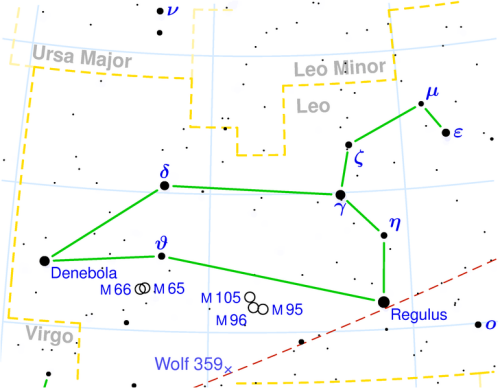
Figure 1. Leo. © 2003 Torsten Bronger.
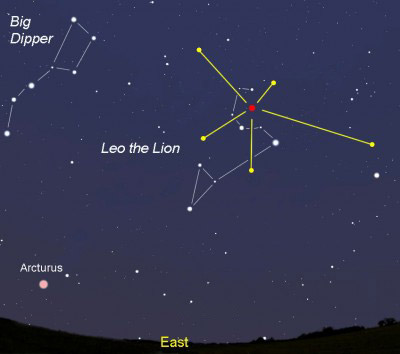
Figure 2. The radiant (shown in red) of the Leonid meteor shower.
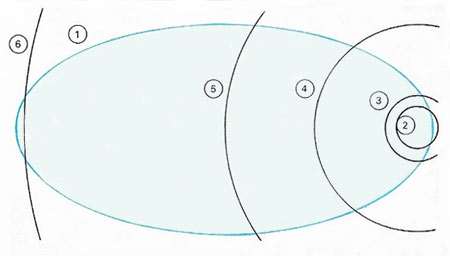
Figure 3. The orbit of the Leonid meteor stream (1) intersects the orbits of Earth (2), Mars (3), Jupiter (4), Saturn (5) and Uranus (6). Because the meteors are not distributed evenly, major meteor showers appear only occasionally. The average interval was once just over 33 years, but the expected showers of 1899 and 1933 were missed because the shower orbit had suffered planetary perturbations.
Leo, the Lion, is a large, prominent constellation, the fifth of the zodiac, which dominates the northern spring sky. It lies between Virgo and Cancer and to the south of Leo Minor and Ursa Major; the Sickle asterism, formed by the stars Alpha (Regulus), Eta, Gamma (Algieba), Zeta (Adhafera), Mu, and Epsilon Leo, outlines the Lion's head (Figure 1). See below for details of the constellation's brightest stars and interesting deep sky objects.
Leo I
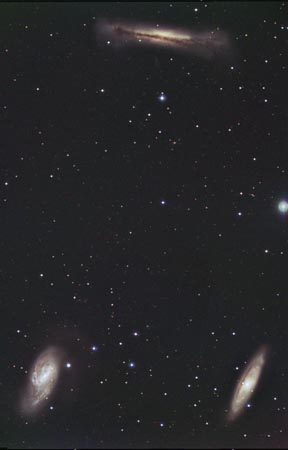 |
| Figure 4. The Leo Triplet. Image courtesy Richard
Crisp.
|
Leo I is a large, prominent group of predominantly spiral galaxies. It consists of two main subgroups: the M66 Group and the M96 Group. The former lies about 35 million light-years away and is centered on the interacting spirals M65 (NGC 3623), M66 (NGC 3627), and the edge-on NGC 3628, also known as the Leo Triplet (see accompanying photo). Not far from the M66 Group, and almost certainly physically related to it, is the much larger M96 group dominated by M96 itself, about 41 million light-years away, M95, M105, and NGC 3384. Fainter members of the M96 Group include NGCs 3299, 3377, 3377A, 3384, 3412, and 3489. The slightly more distant S0 or early Sa galaxy NGC 3593 is probably also a member.
Leo I is also the name of a dwarf spheroidal (dE3) galaxy that, at a distance of about 880,000 light-years, is the most remote satellite galaxy of the Milky Way and hence also a member of the Local Group. Discovered in 1950, it has a diameter of about 6,000 light-years. Because it lies close to Regulus in the sky (making study of it difficult in the bright star's light) it is sometimes known as the Regulus Dwarf, and also catalogued as DDO 74, UGC 5470, and Harrington-Wilson 1.
Leo II
Leo II is a large collection of galaxy groups clustered about 30 million light-years to one side of the Virgo Cluster.
Leo II is also the name of a dwarf spheroidal (dE0) galaxy that, at a distance of about 800,000 light-years, is a remote satellite galaxy of the Milky Way (the second furthest, after Leo I) and hence also a member of the Local Group. Discovered in 1950, it has a diameter of about 4,200 light-years. Also known as Leo B, it is catalogued variously as DDO 93, UGC 6253, and Harrington-Wilson 2.
Leo III
Leo III is a dwarf irregular galaxy that lies at a distance of 2.25 million light-years and is a member of the Local Group. Also known as Leo A, it is catalogued as DDO 69 and UGC 5364, it was discovered in 1942 by Fritz Zwicky.
Copeland's Septet
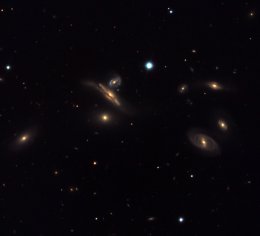 |
| Fig 5. Copeland's Sextet.
|
Copeland's Septet (Hickson 57) is a close grouping of seven major galaxies that lies about 480 million light-years away, about 8° NW of Denebola. It was discovered by Ralph Copeland (1837–1905) in 1874 while he was employed as an observer under Lord Rosse. Copeland probably first observed the group while using the 72-inch "Leviathan of Parsonstown" at Birr Castle.
The galaxies have NGC numbers of 3745, 3746, 3748, 3750, 3751, 3753, and 3754, apparent magnitudes between 13.6 and 15.2, and angular sizes between 0.4 × 0.3 arcminutes and 1.7 × 0.5 arcminutes. The entire group spans about 5 arcmin and is centered around RA 11h 38m, Dec 22° 00'. The barred spiral NGC 3746 (Hickson 57b) was the host galaxy for Supernova 2005ba and also Supernova 2002ar, a Type Ia supernova that reached a maximum magnitude of 16.5.
Leonids
The Leonids is an annual meteor shower that reaches its maximum on November 17–18 and has its radiant point in Leo, near the center of the Sickle asterism (Figures 2 and 3). The shower provides modest displays in most years but spectacular meteor storms every 33 years; rates of 60,000 meteors per hour were recorded in 1966.
The Leonids are fast-moving meteors, entering Earth's atmosphere at about 250,000 kilometers per hour, and leave many trains. Their parent body is the comet Tempel-Tuttle.
Bright stars and other interesting objects in Leo
| Stars brighter than magnitude 4.0 | ||||||
|---|---|---|---|---|---|---|
| star | vis mag | abs mag | spectral type | distance (ly) | RA (h m s) | Dec (° ' ") |
| Alpha (Regulus) | 1.36 | -0.52 | B7V | 77 | 10 08 22 | +11 58 02 |
| Gamma (Algieba) | 2.01 | -0.92 | K1IIIbCN+G7IIICN | 126 | 10 19 58 | +19 50 30 |
| Beta (Denebola) | 2.14 | 1.91 | A3V | 36 | 11 49 04 | +14 34 19 |
| Delta (Zosma) | 2.56 | 1.32 | A4V | 58 | 11 14 06 | +20 31 25 |
| Epsilon (Asad Australis) | 2.97 | -1.46 | G0II | 251 | 09 45 51 | +23 46 27 |
| Theta (Chort) | 3.33 | -0.35 | A2V | 178 | 11 14 14 | +15 25 46 |
| Zeta (Adhafera) | 3.43 | 1.02 | F0III | 99 | 10 16 41 | +23 25 02 |
| Eta | 3.48 | -5.60 | A0Ib | 2,130 | 10 07 20 | +16 45 45 |
| Omicron (Subra) | 3.52 | 0.43 | A5V+F6II | 135 | 09 41 09 | +09 53 32 |
| Rho | 3.84 | -7.38 | B1Ib | 5,720 | 10 32 49 | +09 18 24 |
| Mu (Rassalas) | 3.88 | 0.83 | K0IIIbCNCaBa | 133 | 09 52 46 | +26 00 25 |
| Iota (TszE Tseang) | 4.00 | 2.08 | F2IV | 79 | 11 23 55 | +10 31 45 |
| Other objects of interest | ||
|---|---|---|
| name | type of object | notes |
| M65 (NGC 3623) | galaxy | An edge-on type Sb spiral that forms a conspicuous triple with M66 and NGC 3628. Magnitude 9.3; angular size 10.0' × 3.3'; distance: 35 million light-years; RA 11h 18.9m, Dec +13° 05' |
| M66 (NGC 3627) | galaxy | A physical partner of M65 and another edge-on Sb spiral. Magnitude 9.0; angular size 8.7' × 4.4'; RA11h 20.2m, Dec +12° 59' |
| M95 (NGC 3351) | galaxy | A face-on type SBb barred spiral that forms a pair with M96 (see Leo I). Magnitude 9.7; angular size 7.4' × 5.1'; RA 10h 44.0m, Dec +11° 42' |
| M96 (NGC 3368) | galaxy | An Sb galaxy in partnership with M95. Like all the above galaxies, it is visible with a small telescope. Magnitude 9.2; angular size 7.1' × 5.1'; RA 10h 46.8, Dec +11° 49' |
| M105 (NGC 3379) | galaxy | A type E1 elliptical. Magnitude 9.3; angular size 4.5' × 4.0'; RA 10h 47.8m, Dec +12° 35' |
| Constellations |
| Andromeda | Antlia | Apus | Aquarius | Aquila | Ara | Aries | Auriga | Bootes | Caelum | Camelopardalis | Cancer | Canes Venatici | Canis Major | Canis Minor | Capricornus | Carina | Cassiopeia | Centaurus | Cepheus | Cetus | Chamaeleon | Circinus | Columba | Coma Berenices | Corona Austrina | Corona Borealis | Corvus | Crater | Crux | Cygnus | Delphinus | Dorado | Draco | Equuleus | Eridanus | Fornax | Gemini | Grus | Hercules | Horologium | Hydra | Hydrus | Indus | Lacerta | Leo | Leo Minor | Lepus | Libra | Lupus | Lynx | Lyra | Mensa | Microscopium | Monoceros | Musca | Norma | Octans | Ophiuchus | Orion | Pavo | Pegasus | Perseus | Phoenix | Pictor | Pisces | Piscis Austrinus | Puppis | Pyxis | Reticulum | Sagitta | Sagittarius | Scorpius | Sculptor | Scutum | Serpens | Sextans | Taurus | Telescopium | Triangulum | Triangulum Australe | Tucana | Ursa Major | Ursa Minor | Vela | Virgo | Volans | Vulpecula |


